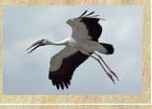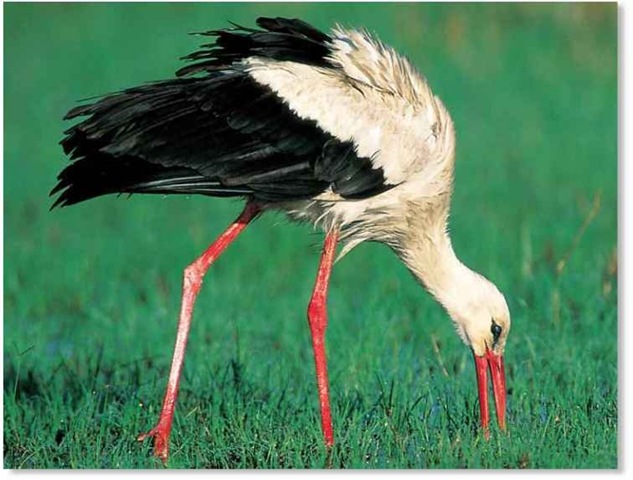ORDER
Ciconiiformes
FAMILY
Ciconiidae
GENUS & SPECIES
key features
| • A tall, stately relative of the vultures
• Strides across grassland and marshes; stabs frogs and other small animals with its daggerlike bill
• Often builds nest on roofs and chimneys
• Migrates in flocks thousands strong, covering great distances with energy-saving, soaring flight
where in the world?
Breeds across Europe, from France east to Russia, south to Spain; in North Africa, parts of central Asia, South Africa; winters in Africa, Iran and India

Celebrated in the folklore of many countries and honored by local traditions, the white stork has for centuries been a welcome guest in many European villages and towns.
HABITAT

A Reedy hiding place
If safely concealed, the stork stands on one leg to relax.
In summer, the white stork lives in open country. It searches grasslands, meadows and fields of crops or ploughed soil for food and often rests in damp and waterlogged areas that offer cover, such as vegetation around drainage ditches, canals, shallow pools and marshes. It nests and roosts on trees, cliffs, buildings and other man-made structures, such as telegraph poles, water towers and church spires.
In its wintering areas, the white stork frequents cultivated fields and grassland in arid, lowland plains.
CONSERVATION
The white stork has long lived in relative harmony with humans, who welcome its return to its traditional nest sites each spring — some communities even fix nesting platforms to towers and roofs to make “their” storks stay. However, the white stork has declined recently because of intensive farming, overgrazing in its winter range, hunting and an increase in fatal collisions with power lines.
FOOD & FEEDING
A great opportunist, the white stork eats whatever small prey it comes across. Much of its diet consists of earthworms and large insects, especially beetles, locusts, and grasshoppers; in parts of Africa, it is known as “grasshopper bird.” It also hunts snakes, lizards, frogs, toads and mammals, such as voles, mice, hamsters and moles.
The white stork devours most prey whole; it stabs larger victims to death with its pointed bill, before slashing their bodies to devour them piece by piece. When prey is abundant, the stork feeds rapidly: one individual caught and ate 44 mice, two hamsters and a frog, all in one hour.
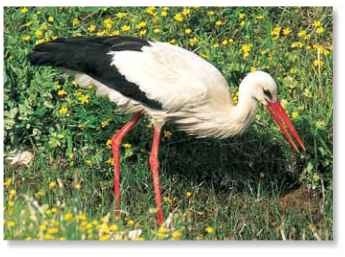
A Spring-loaded
The white stork hunts with neck hunched up, poised to lash out.
BEHAVIOR
The white stork’s spectacular migrations to and from its winter quarters have been observed since biblical times; these journeys are difficult to miss, as the stork travels in huge flocks of up to 1,000 birds.The flock soars on thermals — spirals of warm air that rise up from ground heated by the sun. There are no thermals over sea, so storks mass together in larger numbers at certain locations to cross stretches of water at their narrowest points: crossing places include the Strait of Gibraltar and the Bosporus — the narrow channel that separates Asia and Europe.
Up, up and away Migrating storks use the lift created by currents of air rising over cliffs.
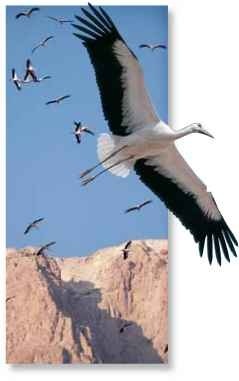
TOWER OF STRENGTH
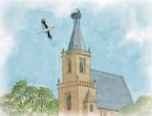
Departs
Many storks nest on man-made sites. An adult flies off to find food, leaving its mate to guard chicks.
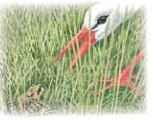
Hunt…
It reaches a nearby hunting ground;spots a frog and quickly seizes it in its powerful bill.
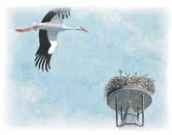
Return…
As the stork returns to its nest, its mate flies off to go on a hunting trip of its own.
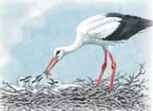
Feed
The stork passes the frog it has caught to a chick, and stays on guard duty until its mate returns.
BREEDING
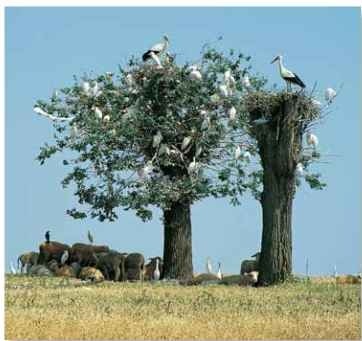
A High society
Storks may nest alongside other birds, such as cattle egrets.
By end of February, the first white storks have begun to arrive at the species’southernmost breeding grounds; they
may not reach northern and eastern parts of their range until early April.
The male is faithful to his old nest rather than a mate; he arrives alone, ready to court the first female that appears. However, some pairs stay together for several seasons.
After an energetic display involving head-bowing, neck-stretching and bill-clattering, the female lays an average of four eggs. Both sexes take turns incubating a clutch for over a month. The downy chicks are fed by parents on regurgitated food for about nine weeks. After three more weeks, the chicks are fully independent.
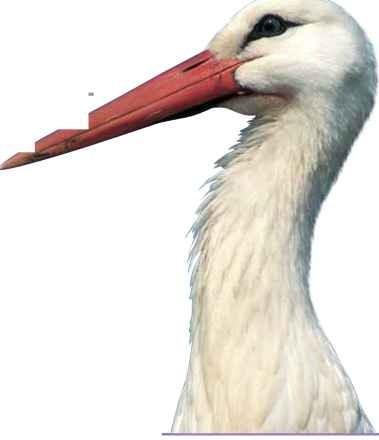
The white stork reaches speeds of 27 mph during its long migrations.
Domestic chickens, ducks and cats have all fallen prey to the white stork — it was even seen devouring a dead baby goat.
Some small birds, such as sparrows and starlings, use the bulky nest of the white stork as a strong, secure site on which to build their own nest.
PROFILE
White Stork
The white stork’s plumage and graceful stride belie that it’s a deadly predator that kills with lightning strikes of its bill.
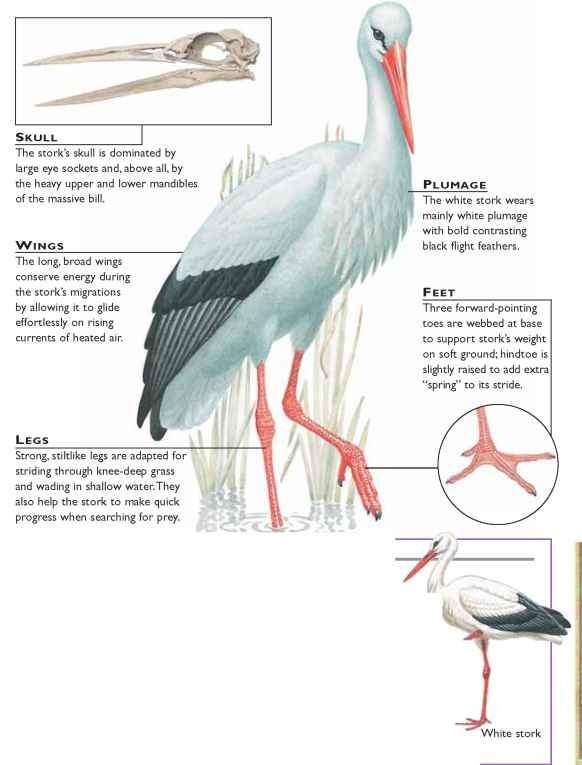
CREATURE COMPARISONS
Despite its name, the black stork (Ciconia nigra) is a more colorful bird than the marginally larger white stork. Its head, neck and upperparts appear black from a distance; at close range their true colors are a blend of glossy greens, browns and purples.The black stork has a red ring around its eye, whereas the white stork’s eye ring is black.
Unlike its more familiar relative, the black stork avoids contact with humans. It nests in trees in undisturbed open woodland near rivers, lakes and swamps, over a wide range from Spain to China.
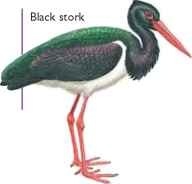
| vital statistics Weight Male 5.5-9.5 lbs.; female 5-9 lbs. |
|
| Length | 3.3-3.8′ |
| Wingspan | 3.8-5.5′ |
| Sexual Maturity | 4 years |
| Breeding Season | April-July |
| Number of Eggs | 1-7; usually 3-5 |
| Incubation PERIOD |
33-34 days |
| Fledging Period | 58-64 days |
| Breeding Interval | 1 year |
| Typical I Diet | Range of small prey: insects, worms, frogs, snakes, lizards, mammals, birds |
| Lifespan | Up to 35 years |
Related species
• The white stork is one of 19 species in the family Ciconiidae, which includes the wood stork | Mycteria americana (below), the only stork native to North America. Storks belong to the order Ciconiiformes; relatives in this order include herons and ibises.
